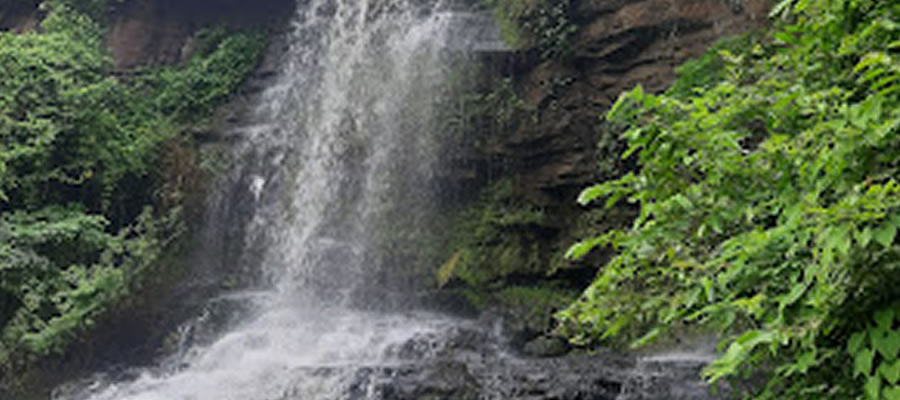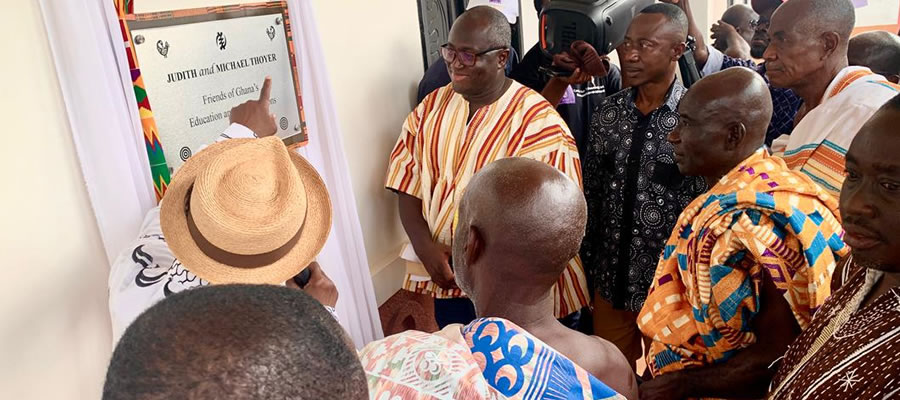

Physical and Natural Environment
Location and size
Sekyere Kumawu District (formerly Sekyere Afram Plains District) is one of the 43 administrative and political Districts in the Ashanti Region of Ghana. It was among the Thirty-Two (32) districts established in the country in 2008 through legislative Instrument (LI) 1838. The district was inaugurated on Friday 29th February, 2008. Before then, it was part of Sekyere East District. The Administrative capital is Kumawu. In 2012, the Afram Plains part of the District was carved out and the old name of the District was given to the new District. This led to the adoption of the new name “Sekyere Kumawu District Assembly”.
The Sekyere Kumawu District is located between Latitudes 0° 200 and 1° 20’ North and Longitudes 0° 450 and 1° 150 west. It covers an estimated land area of 576.58 square kilometres, which forms 6.2 percent of the total land size of the Ashanti Region. The District shares common boundaries with other Districts in the region. These are the Sekyere Central District to the west, Sekyere East and Asante Akim North districts to the South and the Sekyere Afram Plains District to the east. Kumawu, the capital is about 54 kilometres north-east of Kumasi, the regional capital.
Figure 1.6: Sekyere Kumawu District Map
Climate
The Climatic condition in the District conforms to that of the Middle Belt of Ghana, which is the Forest and Savannah-Transitional Zones. The District has a monthly mean temperature of 24oC. Rainfall comes in two seasons a year, March-April and the major one in June-October. The District has relatively high humidity. Large scale of clearing of water sheds, particularly around Kumawu is likely to be one of the major causes of dwindling rainfall and effect of acute water supply especially during the dry season. Logging is also another threat to the environment. Removal of larger and smaller tree is also having a negative impact on the Ecosystem.
Vegetation and Forest Reserves
Basically, the vegetation consists of Guinea savannah woodland and moist semi-deciduous forest types. This vegetation type supports the growth of big and tall trees of different kinds such as Wawa, Sapele, Odum, and Mahogany. The Northern part of the District is covered with Guinea Savannah and consists of short deciduous fire resistant tree. The savannah region covers about 60 percent of the District while the moist semi-deciduous forest zone accounts for the remaining 40 percent (DPCU 2013).
The district is also endowed with a lot of eco-tourism sites that need to be developed. Some of these sites are Bomfobiri Wildlife Sanctuary and BoumFum Forest Reserve. Information available indicates that Bomfobiri was gazetted in 1975 and protects wildlife such as buffaloes, monkeys and bush dogs. The activities of the encroachers especially hunters have affected the wildlife situation in the district. The activities of sand winners have also affected the environment and the wildlife they disappear entirely in the season. Figure 1.7 is a map showing the vegetation cover and forest reserves in Sekyere Kumawu District.
Relief and Drainage
The District is divided into two (2) by a Kwahu scarp running westwards. The southern portion of the scarp has undulating characteristics, with the highest point of about 400 meters at Woraso, around Kumawu. In the south-west portion is the heavily dissected down slope of the Wenchi-Koforidua scarp with hills rising to 330 meters. Overlooking the Ongwam and Boumfum Valleys, a gentle slope extends to the north-east, rising to about 105 meters above sea level.
The northern part of the district, which lies within the basin of the Volta River, is drained by Afram, Ongwam and Boumfum Rivers. Most of the rivers are sea land in nature. They overflow their banks during the rainy season and may disappear entirely in the dry season. Even in the case of river Afram it may become a chain of pools during the dry season.
Geology
The main geological formations that cover the district are the Birrimian and Voltain Sandstone tyes. The Birrimian types are found at Southern part of the district whiles the Voltain sandstone are found mostly at the Northern part. These are volcanic rocks, which have been solidified from molten materials (lava). Below is a map showing the main rock formations in Sekyere Kumawu District.
Figure 1.7: Geology in Sekyere Kumawu
Environmental Situation
Conditions of the Natural Environment
The district is blessed with immense natural resources in the form of fertile lands, forests and wildlife. The exploitation of the arable land in district to meet socio-economic needs of the inhabitants has adversely affected the fragile environment. Uncontrolled bush burning and excessive felling of trees for charcoal burning particularly in the forest zones is fast threatening the bio-diversity, thus putting the fertility of the soil at risk and reducing potential resources of generation yet unborn.
The district is blessed with many tourist sites such as the Bomfobiri Wildlife Sanctuary, Bonfuom Forest Reserve. The Bomfobiri Wildlife Sanctuary which covers an area of about 4921 hectares has several species of buffaloes, monkeys, bush dogs and crocodiles (in the Ongwam River).
Conditions of the Built Environment
Generally speaking most houses in the district are compound with few detached and semidetached in the larger settlements Kumawu, Oyoko, Banko, Sekyere and others. Houses are built with landcrete and few plastered walls.
Roofing in smaller settlements is done with leaves, while few other houses are done with roofing sheets. The foundations of most houses in settlements such as Banko, Temate and Wonoo have been attacked by severe erosion. The condition has been caused by constant erosion from rain and stormy water resulting from poor drainage around houses. Constant weeding and sweeping around houses have contributed to the removal of the topsoil thereby exposing houses to erosions.
Most houses have no toilet facilities attached to them and the inmates depended on the public places of convenience. Few houses have kitchen and the main courtyard is normally used as kitchen. Bathrooms are normally provided in the building plan but after approval, improvised structures serving as bathroom are erected just behind the houses. The resultant problem created by the bathroom is that the waste water (sludge) is not channelled into any proper drainage system and this serves as breeding grounds for mosquitoes.
Soil
The soil found in the District can be divided into grouped according to the geological formation from which they have developed. The four main geological formations are, Granitic, Birimian, Voltarian’ and Alluvium rocks. These formations are subdivided into Associations
Soil developed over Granite Rocks
These are sub-divided into two namely:
• Kumasi – Offin Compound and
• Bomso –Offin Compound
The Kumasi – Offin Compound Association is made up of Six Members namely: Kumasi, Asuansi, Akroso, Nta, Offin and Densu series. The Kumasi series normally occur on summits to upper slope rites and are followed by the Asuansi, Akroso, Nta, Offin and Densu in that order. The Densu series are normally found within the valley bottoms and are very poorly drained.
The Bomso-Offin Compound has large muscovite mica flakes and less of biotite mica flakes which is characteristics of Kumasi and Asuansi series.
The Kumasi and Asuansi series are ideal for the production of tree crops such as cocoa, citrus, coffee, oil palm and food crops such as maize plantain, cassava and cocoyam. The Akroso series are better suited for mechanized cultivation than the Kumasi and Asuansi series. They are also suitable for both food and cash crops. The soils however, have a low inherent, fertility, moderate water-holding capacity and slight to moderate erosion hazards.
The Offin-Densu series are only suitable for rice, vegetables and sugar cane, especially in the dry seasons under appropriate agronomic practices and fertilization. The Bamso-Offin soils are not as fertile as the Kumasi and Asuansi and are easily prone to drought so that cocoa does not survive on them.
Soil Developed Over Alluvium
These are of two main Associations. They are Denteso-Sene and Dukusen-Poramba Associations. The Denteso-Sene soils are found along streams and river valleys within the transitional zone developed from fine-grained voltarian sandstone.
Agricultural Value
The Denteso-Sene soils can be used for the production of vegetables, rice and sugarcane. The Dukusen-Bramba soils are suitable for rice and sugarcane production and when drained they can be put to vegetable production.
Soils Developed Over Birrimian Rocks
These soils are mainly of the Bekwai-Oda Compound Association. They are well drained to moderately well drained upland simple association of Bekwai-Nzema, Kokofu, Akomadan and Afrancho series. They are imperfectly to very poorly drained lowland, simple association of Temeng and Oda series.
The upland deep to moderately deep concretionary to free soils are suitable for plantation, cocoyam, cassava, maize legumes and vegetables. Plantation crops like oil palm, cocoa, coffee, citrus and pear also do well on these soils.
Solid Developed Over Voltarian Rocks
These are of eight associations and include Bediesi-Suatawa, Yaya-Pimpimso, Damongo-Tanoso, Ejura-Denteso, Kimtampo-Techiman, Kintampo, Nyankpala-Kpelesawgu-volta and Kowani-Kesele.
The Bediesi-Suatawa is extensively used to produce wide range of crops such as maize, yam, cassava, plantain, cowpea and groundnut.
The soils of Yaya-Pimpimso are generally shallow and are therefore considered poor for agricultural production. The Damongo-Tanoso soils are low to medium in fertility. The Ejura-Denteso soils are good agricultural soils suited for both hand and machine cultivation. They are used extensively for the production of maize, yams, cassava, groundnut, tobacco, keraf, sorghum, millet, soya beans, cowpea etc.
The Kintampo-Techiman soils are not suitable for crop production. They are better utilized for rough grading, soils of Nyankpala-Kpelesawgyu-Volta Association are marginal soils for crop production due to their shallow depth. The Kowani-Kesele series are shallow in depth. They are also gravelly and so not suitable for cultivation. The Kintampo Association soils are found on flat-topped low lying hills with completely bare rocky surfaces. The soils are not suitable for agriculture.
Nature of Physical Development
Physical planning and development in the district can be best described as poor and uncoordinated to the great extent. Almost all the towns including the district capital are without planning schemes and even where one exists, it is not properly applied on the grounds. For instance towns like Oyoko, Bodomase have approved old layout but new sites are not covered. Developers develop without building plans and development permits. Report from the Town and Country Planning unit of the Assembly indicates that since the creation of the Assembly in 2008 only handful or developers have submitted their building applications for approval.
Development control problems in the District include:
1. Inadequate and substantive staff for the unit
2. Inadequate financial and logical support
3. Inadequate and outmoded schemes of some communities
4. Lack of planning schemes for some communities
5. Unauthorized development structures
6. Operation of quack surveyors and draughtsman
7. Encroachment on public right pf space (Nature reserves, open space
Roads, Cemeteries, Water courses and others)
8. Inadequate office space
9. Poor public knowledge about physical development and planning
Aesthetic Features and Land Management
The aesthetic features of the district are generally beautiful when viewed from a far particularly its vegetations and hills. Major towns like Kumawu, Bodomase, Abotanso and Woraso are surrounded by hills and beautiful vegetations. However, cursory look indicates that as a result of gulley erosion most of the buildings have their foundations hanging.
Most of the towns also have poor drainage system. Also lack of technical know-how on landscaping issues in the communities affected them negatively. Uncontrolled movement of livestock by Fulani herdsmen have also kept on destroying landscape plants and vegetation in the district.
The land Management system in the district is mainly Abusa system where the farmer takes two-thirds of the produce while the land owner takes one-third. This system does not augur well for increased productivity as they serve as disincentive to the farmers. However one advantage of the system is that settlers are allowed to hold their farms for longer period. This creates a situation of security and creation of permanent settlement in the farming areas of the district.
Implications for Development
The physical and natural environments discussed implied that:
• The Rivers and streams in the district cannot be relied upon for any meaningful irrigation agriculture due to their seasonal nature
• The soils in the district are generally good for agriculture
• The effects of human activities on the environment are alarming. For example unwarranted destruction of the forest trees and felling of trees for commercial charcoal burning should be monitored closely.
• The Government and the District Assembly must pay more attention to develop the road network of the district.
Impact of Human Activities
Human activities in the district have an adverse impact on the environment and on the lives of the people. Bush burning has destroyed and continues to destroy a greater part of the vegetation cover and the bio-diversity in the district. Thus, the fertility of the soil is at risk and reducing potential resources for future generation. Tree felling for commercial charcoal burning in the Northern portion of the district is another potential activity that has caused and continues to cause great destruction to the vegetation cover in the district. Due to tree felling for charcoal burning, the vegetation in the area has fast degenerated into secondary forest and dried savannah.
2:03 PM 17-Oct-18
Date Created : 11/28/2017 3:21:51 AM











 facebook
facebook
 twitter
twitter
 Youtube
Youtube
 +233 593 831 280
+233 593 831 280 0800 430 430
0800 430 430 GPS: GE-231-4383
GPS: GE-231-4383 info@ghanadistricts.com
info@ghanadistricts.com Box GP1044, Accra, Ghana
Box GP1044, Accra, Ghana